4WD Hunter
by Ron and Viv Moon
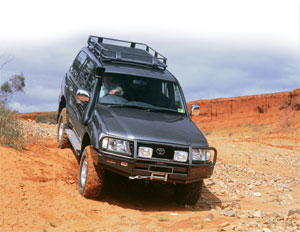 Setting-up the perfect rig
Setting-up the perfect rig
You don’t have to be the keenest hunter in the world to know that the vehicle you want to own is a good four-wheel drive. Forget about the all-wheel drives, ‘soft roaders’ and ‘compacts’ that seem to be appearing like magic in today’s vehicle marketplace; they’re meant for the blacktop or, at worst, a dirt road - and not a particularly rough one.
What we hunters need and what most of us desire is a ‘real’ 4WD. For many, a Cruiser or a Patrol may top the list, but for less money and for a vehicle that exhibits a few more on-road manners you shouldn’t wipe off the Pajeros, Jackaroos, Pathfinders and Prados, which all make great touring, hunting and around-town vehicles.
Whether you go for a new machine or a clean secondhand unit, a diesel-powered four-wheeler or a petrol rig, it is really up to you and your friendly bank manager as to what you end up buying. But whatever it is, it will need a few accessories to make it the dream hunting vehicle you’ve always wanted.
So, where do you start and how much do you have to spend to make your new rig a tough, capable four-wheeler ideal for all the places you want to go?
Most 4WD owners would agree that you can spend thousands of dollars setting up a new rig, but, whatever you do, buy the best accessories you can afford, shop around and stick to the brands that have a good reputation for quality and reliability.
Barwork
Most 4WDs are fitted with a bull-bar and that’s not because it looks good or adds to your macho image. They are there to protect your expensive new investment from wayward ’roos and stock when you are travelling the backblocks and for those times the track narrows and you end up pushing scrub out of the way just to get to your favourite camp-site.
Bars can be made from alloy, steel and even plastic and there are a host of brands on the market. Some aren’t worth fitting, as the bumper bars fitted to new rigs would offer better protection.
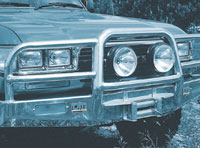 Steel bars offer the best protection by far, but are also, generally, the heaviest. Alloy bars vary quite a bit in their protection capability, depending on how thick the material is and how they are constructed, but there are more styles out there and they look good. Mind you, polished alloy bars demand a regular dose of elbow grease to keep them looking great, so if you are anything like us, the painted ones are the way to go.
Steel bars offer the best protection by far, but are also, generally, the heaviest. Alloy bars vary quite a bit in their protection capability, depending on how thick the material is and how they are constructed, but there are more styles out there and they look good. Mind you, polished alloy bars demand a regular dose of elbow grease to keep them looking great, so if you are anything like us, the painted ones are the way to go.
The plastic bars available, and there’s really only one manufacturer - Team Poly, are limited in their styling and don’t rate highly as far as looks go. Still, they offer reasonable protection and are lightweight, but they can flex a lot. That means a reasonable hit from a ’roo may bend the bar back into the vehicle’s bodywork, bending the sheet metal and, while the bar will almost definitely spring back out to its original position, the damage may have already been done.
If you want a winch, make sure the bar has the correct mounting available for it, which means, no matter if your bar is alloy, steel or plastic, it has steel mounting brackets to carry the weight and the strain that a winch exerts.
For steel products see the ARB and TJM range of bar work, while for alloy products you can check out the bars available from TJM and East Coast Bullbars (ECB). For plastic products, as well as the ECB range, check out the nearest Opposite Lock store.
You’ll find you’ll be able to get SRS air-bag-compatible bull-bars from all the major manufacturers that suit the latest crop of SRS airbag-equipped 4WD vehicles.
Most good bull-bars cost between $800 and $1400 an item, depending on how fancy they are.
Side steps and rails
The same brand names are the ones to look for in the side step or side rail market. The question you have to ask is if you really need them and, while they add to the overall protection of your vehicle, they also add weight. Really, you only require side rails if you are doing a lot of scrub work and then you should make sure they are mounted off the chassis. Body-mounted side rails and steps are as weak as water.
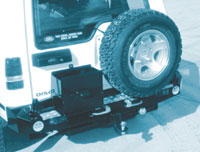 Rear steps
Rear steps
Fitting a rear step is also a good investment and some of the better ones incorporate a towbar into the design, as well as a swing-away tyre carrier. TJM has a good range in this field, but another company - Kaymar Engineering - specialises in making this product and once again they are widely available through good 4WD accessory shops. The one we particularly like is the rear step that can carry two wheels and tyres. Another good option from Kaymar is a work light that mounts on the back. It comes in handy for those late night skinning and butchering jobs out in the bush.
Roof racks
As far as roof racks go, there is a wide choice of heavy-duty racks available from ARB, TJM, ECB and Opposite Lock. Once again full-steel racks can be heavy, while alloy ones are a lot lighter.
For many people, roof bars are the way to go, as they are lighter, easy to take on and off and are flexible in that you can use them to carry surfboards. You can also add a basket to carry other gear or add brackets to carry skis and bikes or a fully enclosed plastic container. Thule and Rhino are just a couple of the brands around that are worth looking at.
While TJM, Opposite Lock and ARB have their own dedicated outlets around the country, you’ll find their products and those of the other makers in various 4WD stores across Australia.
Suspension
'Why in the hell should I change my suspension?’ we hear you ask. Well, you don’t have to, but your vehicle will drive better, carry heavier loads, be much more capable off-road and a darn sight more comfortable on-road if you do something with your suspension. That applies to the latest vehicles on the road, as well as the older beasts frequenting the highways and byways of Australia. Most new vehicles come with coil suspension or with coils on the back and an IFS, normally torsion bar equipped, front-end.
If you intend carrying a fair amount of weight, one of the best options you can go for - and it’s not all that expensive - is a set of Polyair air bags. These can be easily adjusted to suit the load you are carrying and they do make a big difference in the handling of your machine.
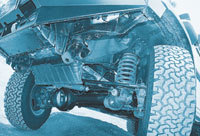 Those carrying heavy loads, like kangaroo harvesters carrying a heap of carcasses to the chillers, may want to have a look at the Aussie-made No Bull Suspension Supports or a more solid rubber affair called an Aeon. These are not adjustable like Polyairs, but they are cheaper, more robust and really help to carry a big load, taking much of the strain off the springs, which allows you to carry big weights without the vehicle dragging its bum on the ground. However, they do little for handling or comfort. The No Bull system comes in two different ratings: 500kg and 1000kg versions and costs about $350.
Those carrying heavy loads, like kangaroo harvesters carrying a heap of carcasses to the chillers, may want to have a look at the Aussie-made No Bull Suspension Supports or a more solid rubber affair called an Aeon. These are not adjustable like Polyairs, but they are cheaper, more robust and really help to carry a big load, taking much of the strain off the springs, which allows you to carry big weights without the vehicle dragging its bum on the ground. However, they do little for handling or comfort. The No Bull system comes in two different ratings: 500kg and 1000kg versions and costs about $350.
A replacement suspension may be the dearest way to go but it is also the best. Here you can modify the suspension to do whatever you want it to do. You can optimise it for comfort, load carrying, wheel travel or fast highway cruising. While all possibilities and desires might not be achievable with an aftermarket suspension, you can come bloody close.
Australia and its manufacturers are world leaders in the suspension market and we have a couple of top manufacturers in the 4WD aftermarket field. Old Man Emu (ARB), XGS Series 2000 (TJM) and Tough Dog Suspension (Opposite Lock) offer great choices of makes and models to suit anyone’s desire.
To help the supplier choose the right suspension for you, make sure you know the weight of your truck and what you want to fit to it, as well as what you intend to carry.
There is a fair price range here, depending on the type of suspension your vehicle comes with. For a full change over, prices start from about $1000 and go up to $2000.
One thing to remember, especially with a new vehicle, don’t waste your money replacing your standard shocks with cheap ones, unless you’re changing the springs. The new shocks found on most of today’s 4WD vehicles are pretty good and while the good aftermarket shocks (OME, XGS Series 2000, Tough Dog and Koni) are better, the cheap ones are not.
Equally as important, don’t expect your shocks to last forever, even good ones. And if you’ve given them a real hard time you’ll be lucky if they last 30,000km, even if they are top brands. Still, most shocks will last the normal traveller 50,000-70,000km, but once past that you should get them checked. You’ll be surprised the difference a pair of good shocks can make.
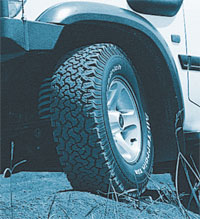 Wheels and tyres
Wheels and tyres
There is a huge array of tyres and wheels on the market, with each new model of vehicle coming onto the market seemingly opting for a different wheel and tyre size. Wheels come in a variety of sizes to suit the four-wheeler, most being 15" or 16" in diameter. The old standard of a 16" rim, 5.5" or 6.0" wide fitted with a 7.50X16 tyre is still around and there is a good choice of rubber to pick from.
Wide wheels, once exclusively 15" in diameter but now more 16" and up to 12" wide, have a vast selection of rubber, which is growing all the time. Most tyres for 15" rims have an overall diameter of 31", slightly smaller than the overall diameter of rubber fitted when you shod your rig with 7.50X16s.
There are a lot of pros and cons for wide or normal width tyres, which we won’t get into here. Whichever way you go there will be self-proclaimed experts, some of whom will agree with you and some who will disagree.
Most tyres fitted as new to 4WD rigs are a passenger (P) or highway-terrain (H/T) rated tyre and they are not great once you drive off the blacktop. Get rid of them as soon as you can.
If you are heading onto the dirt more than once a year, we’d suggest going for the Bridgestone Desert Dueler D693, which has recently been upgraded; the Dunlop Grandtrek AT1 (the only Grandtrek to contemplate); the Cooper SST or the new Cooper Discoverer S/T or the BF Goodrich All Terrain KO. These are the makes and models of tyres we’d choose as all-round rubber - they are all very good on the blacktop and excellent in the dirt.
If you want a good mud tyre capable of handling the mountains in the wet, then go for something with a good gutsy pattern, such as BF Goodrich Mud Terrains, Bridgestone Mud Duelers or ProComp Mud Terrains. If you want something even more aggressive, try the incredible Interco Super Swampers, the Baja Claws or the Simex Jungle Trekkers - that is if you can live with the road noise they make.
Because of their aggressive tread pattern, mud tyres aren’t so great on the bitumen - you learn to live with them, but they are only worth it if you spend a fair amount of time in the bush. If you can have them as a second set of tyres, especially with the super-aggressive rubber we’ve mentioned, it’s probably the best way to go.
Buying a secondhand set of 16" steel rims may only set you back $100, while top-of-the-line alloy rims can set you back about $250 each. Tyres too can vary, from about $150 each to more than $400 each for the super-aggressive tyres. It all depends on what you buy and how big you go.
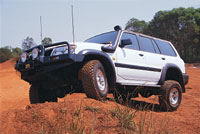 Winches and Lockers
Winches and Lockers
Winches are an expensive accessory and are only really required if you intend to head into really remote, rugged country on your own. If you travel with someone else, a couple of good ‘snatch-um straps’ will get you or your mate out of most troubles.
If you still feel a winch is required, you have a choice of hand winches such as the Tirfa, which won’t set you back an arm and leg, but take a lot more effort to use than the electric or power take-off (PTO) winches that cost about $1800 and up.
Electric winches are the most common out of the powered winches and for the vast majority of winching they are more than adequate. The Warn brand electric winch is the most popular and there will be a model to suit your truck and your winching requirements.
Once you think about buying a ‘locker’ (or a diff-lock), you are becoming a serious off-roader. Once again there are a few brands to check out. ARB has the Air Locker, which is a popular locker for keen four wheelers; TJM has the Lock Right, a good, relatively easily fitted unit and Opposite Lock stores have the wide range of Detroit lockers.
You may be limited in what will suit your vehicle, as most makes don’t cover every vehicle available, especially if you want a front and a rear locker. While the Air Locker is a manually operated unit, the other two makes are auto lockers. Prices start at about $800 and up for a diff lock.
Better lights
There is hardly a vehicle on the market - either new or old - that comes with lights good enough for driving the outback highways of Australia easily and safely. They all require some form of extra lighting.
A pair of driving lights, one with a spot or pencil beam and the other with a wider driving beam, is ideal for most purposes. If you are doing a lot of work in the mountains, a combination of a driving beam and a still wider spread or fog beam may be better for the winding tracks you may be using.
Now there is a lot of junk on the market when it comes to lights. Stick to the brands such as Hella, IPF, Cibie and Bosch. Expect to pay from $300 and up for a decent pair of lights.
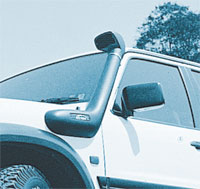 Snorkels
Snorkels
One of the cheapest forms of insurance you can buy for your 4WD vehicle is a snorkel. That’s even more so if you are heading up into the mountains and crossing numerous rivers or heading up to Cape York just after the Wet.
A well-designed and fitted snorkel helps feed clean, dust-free air to the engine and in deep water crossings ensures your engine doesn’t suck a gutful of water. Water can snuff out the fire in a petrol engine and while that can be embarrassing, with a diesel rig much more chronic damage can be done, with a repair bill in the thousands of dollars.
There are only two makes of snorkels to look at: Safari and Air Tech. Safari snorkels are generally available through ARB and Opposite Lock stores, while Air Tech snorkels are supplied through TJM stores. Expect to pay in the vicinity of $400 for a good snorkel.
What else?
There is a lot more you can add to a 4WD to make it suitable to your specific needs: better seats for those long hauls through the outback; UHF and HF radios for communication; turbos for more pulling power; better air cleaner elements to ensure you feed your engine with the cleanest of air; long-range fuel tanks to give you a range of 1000km-plus; air pumps to reinflate your tyres after a run on the sand and storage systems to keep all your camping and recovery gear in their proper place.
Probably the best way to find out what is available for your truck and your own particular needs and to keep abreast of what is happening on the 4WD scene is to take a look at the 4WD specialty mags, such as 4x4 Australia or head along to one of the many 4WD shows that are held annually in most cities.
If you’re not careful, your newfound truck will keep you broke. At the same time, it will open up a whole new world of travel and hunting possibilities. Happy hunting and four wheeling.
